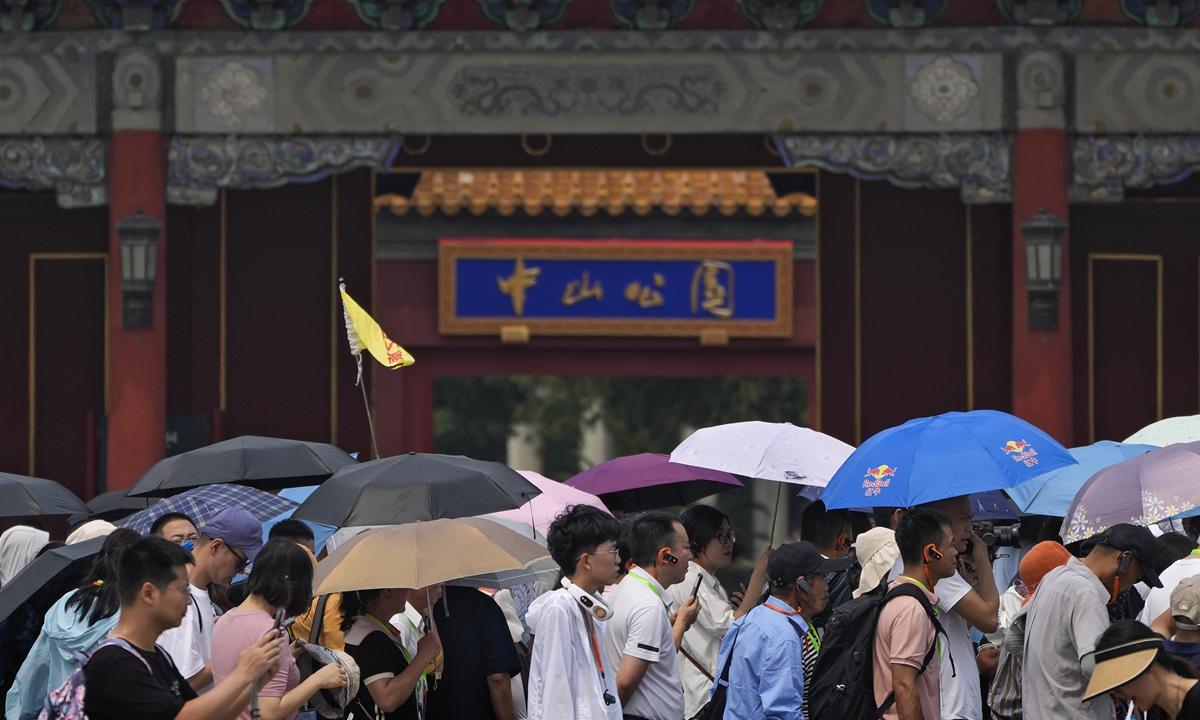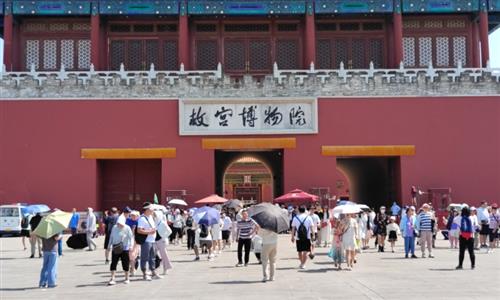North China sizzles under heatwaves, south tormented by heavy rains
Autumn grain crops unlikely to be significantly affected

Tourists carrying umbrellas line up to enter the Forbidden City on a hot day in Beijing, June 25, 2023. Beijing and parts of northern China are experiencing record temperatures, and authorities urged people to limit their time outdoors during a long holiday weekend. Photo: VCG
China has been experiencing heavy rainfalls in its southern region and unusually high temperatures in the northern region recently. Chinese experts said the country needs to make scientific plans and full preparations to deal with potential extreme weather, but noting that the impact of the recent unusual weather conditions on the autumn grain crops will be limited.
Multiple regions including parts in Central China's Hunan Province and South China's Guangdong Province and East China's Zhejiang Province and Shanghai have been hit by heavy rainfalls since Saturday, while the temperatures in North China's Beijing, Tianjin, central part of Hebei Province and northern part of East China's Shandong Province reached 39-41.1 C, according to the China Meteorological Administration on Sunday.
In the next three days, parts of the regions in East China's Anhui Province, Southwest China's Sichuan Province and other areas are forecasted to see heavy rainfall, as well as the risks of mountain floods, geological disasters and waterlogging in urban and rural areas. The intensity and scope of high temperatures in North China and other regions are expected to ease on Sunday and Monday, but the high temperatures will return on Tuesday in some regions, according to the administration.
Experts have said that in the context of global warming, the combination of moderate and above intensity El Nino events might bring more extreme weather in the future.
The current weather situation generally conforms to the rules of the development of El Nino weather event with flooding in the southern areas and drought in the northern areas in the country, Ma Jun, director of the Beijing-based Institute of Public and Environmental Affairs, told the Global Times on Sunday.
During the development of El Nino, it's normal to see flooding caused by rainfalls in the southern areas and drought caused by high temperatures in the northern areas. It is necessary to prevent drought in the northern areas of the country, Ma noted.
Extreme heatwaves not only increase health risks such as heatstroke, and heat-related illnesses, but can also cause damage to infrastructure. They can also trigger wildfires, leading to air pollution. The persistent occurrence of extreme heat can further contribute to the development of compound meteorological disasters, affecting local agricultural and industrial production, water resources, ecological environment, energy supply as well as people's daily life, according to Ma.
In response to that, we need to develop scientific plans and make thorough preparations, Ma said.
Li Guoxiang, a research fellow at the Chinese Academy of Social Sciences, told the Global Times on Sunday that the extreme weather in part of the regions will have "little impact" on the autumn grain production.
Although it is still uncertain if the high temperatures will persist, it is wise to be prepared to prevent drought in the northern areas as well as flooding in the southern areas, according to Li.
At least 185 red alerts for high temperatures were issued across China including Beijing, Tianjin and the neighboring provinces of Hebei and Shandong on June 23, according to media reports.
Since June this year, there have been two regional high temperature weather processes - from June 14 to 18 and from June 21 to 24 - in the Beijing-Tianjin-Hebei region, with the average number of high temperature days reaching 9.5, according to the meteorological administration. It's predicted that the region will face one more process of high temperature from June 27 to 30, said the administration.


